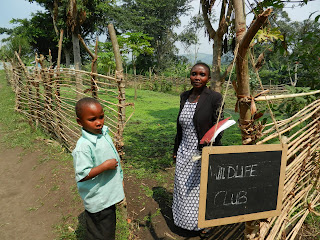Yesterday I organized for an outreach educator (Lawrence) from Tooro Botanical Garden in Fort Portal to visit Kasiisi Primary where all five core school WLC teachers were ready to learn more about types and benefits of gardens. He also brought a detailed field book of 85 indigenous trees. Planting gardens and trees is a big theme among WLCS, but unfortunately there’s not much education about which trees should be planted where. In fact, most are exotic plants (like eucalyptus and pine), which of course, end up taking up more of the local resources, especially water and nutrients from the soil, than do indigenous trees, yet those are the ones the government encourages.
Since I mentioned my pet peeve, I might as well go into more detail and get it out of my system: I despise eucalyptus trees. Eucalyptus trees have a powerful tap root that finds the water table and sucks the life out of it. It also leaves the soil around itself infertile for some 30 years, so I've hear, but I have to do more research. It also can only be killed using pesticides. Like a weed, if you cut the tree, it grows back; hence the reason the government wants people to choose it for their fuel wood. It is fast and efficient, but only from a short-sighted perspective. I was thinking of asking the Forestry Department for an internship simply to fulfill my curiosity.
What the WLCS teachers and I am learning is that, there are indigenous trees that can be harvested just as quickly. They may not grow back on their own, but they won’t drink up your water table, they won’t starve your wetlands, you can plant other food under them, and after they are gone, when they don’t grow back you can even decide if you want a change of scenery once they are harvested. Not to mention, you don’t have to buy deadly chemicals to get rid of them.
Today was an especially good day with the Wildlife Clubs of Kasiisi Project. Francis and I went to Rweteera Primary school, where they are very serious about starting nursery beds to grow tree seedlings and a botanical garden. They have been very proactive with their ideas to support Wildlife Clubs and it excites me. They showed me their extensive nursery beds which are awesome, and their large garden is ready for seeds to be planted once the “rainy season” comes. Who know these days when the rain is going to come, as everyone says you can’t predict the weather anymore due to global warming, etc.
I wanted to make this a more interactive WLC meeting, so I brought an activity designed and made by Disney World Conservation Fund and Diane Fossey Forilla Fund, that Elizabeth had saved for WLCs. It is a large puzzle with 12 pcs, each piece has a conservation message on it, like “protect the environment you live in”. It comes with a sturdy poster in a tree shape. I had each group of students (there were 13 desks with 4-5 students each) take one piece and discuss its message. Then one person from each group (they volunteered themselves and all but 1 were girls!) stood at the front of the classroom to read in English and explain in Rutooro the message, and find it’s matching space on the tree poster. In the future we might discuss each message in more depth as a class, but for today it was just enough.
 |
| Conservation tree puzzle |
 |
| A gord/water bottle that Annet gifted me |
 |
| Rweteera Primary nursery beds! |
 |
| This tree was planted 2 months ago, and they built a fence to protect it |
 |
| Studying the puzzle piece |
 |
| Annet at entrance to the new garden |
In the morning, I searched a few activities from a 345pg document that I found online, produced by Peace Corps, which I have been slowly filtering through. I found a fun forest song. In fact, it was a great success because the students already knew the tune “When you’re Happy and You Know it Clap our Hands…” Along with the song we discussed a few words like “canopy”, “sloth”, “bugs”, “plush” and “60 feet” – which we calculated into meters.
WORLD ABOVE THE GROUND
(Sing to the tune of "When You're Happy and You Know It")
In the jungle there's a world above the ground
(Above the ground!)-(Say it out loud!)
In the jungle there's a world above the ground
(Above the ground!)
Leaves and branches touch the sky
In the canopy so high
In the Jungle there's a world above the ground.
(Above the ground!)
The canopy is plush and lush and green
(Lush and green!)
The canopy is plush and lush and green
(Lush and green!)
Nearly 60 feet or more
Up above the jungle floor
The canopy is plush and lush and green.
(Lush and green!)
The canopy is home to many beasts
(Many beasts!)
The canopy is home to many beasts
(Many beasts!)
Some may never, ever go
To the forest floor below
The canopy is home to many beasts
(Many beasts!)
They leap and climb and fly among the trees
(Among the trees!)
Monkeys, spiders, sloths and slugs
Frogs and snakes and birds and bugs
They leap and climb and fly among the trees
(Among the trees.)
All groups repeat the first verse together.
THIS WAS A HIT!


No comments:
Post a Comment